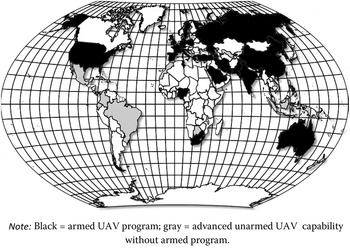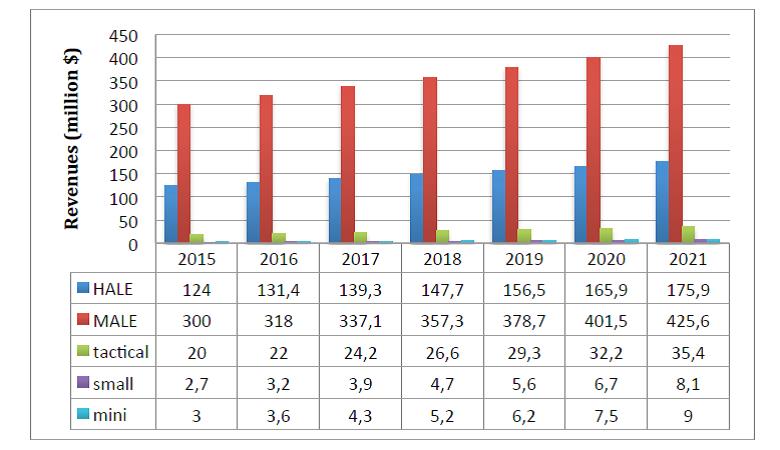The Missile Technology Control Regime and UAVs: A Mismatch between Regulation and Technology
The Missile Technology Control Regime and UAVs: A Mismatch between Regulation and Technology
Paola Sartori*
2017 marked the 30th anniversary of the Missile Technology Control Regime (MTCR), a voluntary arrangement established in 1987 by a group of seven countries.[1] Now counting 35 members, the MTCR is a multilateral export control regime aimed at limiting the proliferation of ballistic and cruise missiles with the potential to carry weapons of mass destruction (WMD).
Throughout its thirty-year history the MTCR has proven, with some limitations, to be an effective multilateral mechanism, especially considering that it succeeded to slow the spread of long-range ballistic missiles. Nonetheless, rapid technological advancements risk overtaking the initial regulatory framework, including the definition of specific benchmarks. Unmanned aerial vehicles (UAV) are of particular concern, as major developments in the sector could end up limiting the efficiency of the MTCR’s export control mechanism.
The MTCR is based on two main documents: the MTCR Guidelines[2] on the one hand and the Equipment, Software and Technology Annex on the other.[3] The first defines a common policy, providing the main objectives of the MTCR and outlining the overall structure and rules for member countries. The Annex provides assistance for the implementation of export controls on a common list of items. Based on two different categories, the document provides varying degrees of export control. Category I includes items that are subject to greatest restraints, namely those systems capable of delivering a payload of at least 500 kg to a range equal to or greater than 300 km. Instead, items including less-sensitive and dual-use missile related components, as well as other complete systems capable of a range of at least 300 km – regardless of payload – are listed under category II, on which members agreed to greater flexibility in transfer constraints.
Under the MTCR, UAVs are divided into these two categories. As for category I UAVs (Item 1.A.2.), the Annex specifies: “Complete unmanned aerial vehicle systems (including cruise missiles, target drones and reconnaissance drones) capable of delivering at least a 500 kg ‘payload’ to a ‘range’ of at least 300 km.”[4] According to MTCR guidelines “strong presumption” of denial should apply on the export of UAVs with these specific features. Category II UAVs (Item 19.A.2), instead, include “Complete unmanned aerial vehicle systems (including cruise missiles, target drones and reconnaissance drones), not specified in 1.A.2., capable of a ‘range’ equal to or greater than 300 km.”[5]
In the 1980s, when the regime was initially set up, this classification made sense. At the time, drones were generally designed for one-way missions, as targets for missile practice, or to perform short-range surveillance missions and had limited utility. Today, applying the same classification to missiles and UAVs ignores the important technological evolution of the latter.
In fact, the present-day generation of drones are more similar to aircrafts than missiles. UAVs are now recoverable platforms, which are able to perform increasingly sophisticated missions and have varied non-military uses, such as border control, search and rescue operations, infrastructure protection but also deployment within the agricultural sector.
The MTCR has not kept up with technological advancements and has fallen short in limiting the proliferation of UAVs and related technology, a process eased by the globalized economy. Considering that the chief components of autonomous air-vehicles comprise dual-use technologies, monitoring their transfer can prove almost impossible.[6] UAV technologies are closely interlinked to those of crewed aircraft, but they also include satellite navigation and guidance furnished primarily by the US Global Positioning System, high resolution satellite imagery that is increasingly commercially available and digital mapping technologies for mission planning. According to some estimates, more than 30 nations already have or are developing armed drones and at least 90 nations, as well as some non-state actors, possess unarmed drones.
Figure 1 | UAV proliferation: global trends

Source: Matthew Fuhrmann and Michael C. Horowitz, “Droning On: Explaining the Proliferation of Unmanned Aerial Vehicles”, in International Organization, Vol. 71, No. 2 (Spring 2017), p. 398.
The UAV market is one of the fastest expanding and dynamic sectors within the broader aerospace, defence and security field. Two major trends are driving UAV technological developments: miniaturization and improved communication and control systems. The former is related to the significant advancements in nanotechnologies that has gradually led to the development and proliferation of smaller, lighter and cheaper systems. As shown by Figure 2, highlighting prospective future revenues by different classes of UAVs, the volume of sales, particularly for smaller UAVs, is expected to double (for tactical UAVs) or even triple (for small and mini systems) in the coming years.
Figure 2 | Estimated revenues by (military) class of UAV: 2015-2021

Source: Alessandro R. Ungaro and Paola Sartori, I velivoli a pilotaggio remoto e la sicurezza europea. Sfide tecnologiche e operative, Roma, Nuova Cultura, 2016, p. 84 (Quaderni IAI No.16), http://www.iai.it/en/node/6614.
Turning to the second major trend, developments within the area of communication and control systems are increasing the autonomy of UAVs. While UAVs are often associated with remotely controlled aircrafts, the evolution of specific technologies is enhancing their capacity to conduct autonomous operations with little or no human control. While most advanced UAVs offer the possibility to pre-program flights, today commercially available systems also contain a certain degree of autonomy, mostly related to software for flight stabilization.
Major advancements in this regard have led to the enhancement or introduction of a varied range of capacities. For instance, the possibility to combine information collected by using different types of sensors (sensors fusion); or the ability to determine optimal flight routes on the basis of certain objectives and mission parameters (e.g. obstacles or fuel requirements) thanks to the development of sense and avoid systems. In addition, by determining optimal control manoeuvres, the vehicle can be constrained to a specific trajectory (trajectory generation and regulation).
Technological progress has also introduced the possibility to elaborate the optimal distribution of tasks amongst a group of agents (including UAVs) by taking into account time and equipment constraints. Moreover, in order to maximize the chance of success in any given mission scenario, research is exploring the possibility to elaborate cooperative tactics by entrusting activities between agents.
In light of the abovementioned considerations, the actual efficacy of the MTCR in controlling UAV technology comes into question. Many new features introduced by these technological advancements are not even considered by the existing MTCR categories. High rates of speed, autonomy, robust surveillance payload, low observable features as well as anti-aircraft countermeasures are all factors that can increase the level of risk inherent in each class of UAV systems, including smaller ones.
For instance, category II export models can deliver any payload up to a range of 300 km according to the MCTR Annex. Nonetheless, considering that a small UAV could potentially deliver kilogram quantities of biological agents such systems represent a real danger, and now account for up to 80 percent of all UAVs on the market.
Moreover, new UAV applications such as “swarming”, enabled by increased levels of autonomy, could also pose real threats to public security. The use of UAVs in swarms allows widening range, flight duration as well as maximising payload capacity, thus potentially creating highly lethal capabilities. Nonetheless, the deployment of a fleet of small UAVs would fall outside category I and thus not be subject to the most stringent export controls under the MCTR.
Due to their massive proliferation, significant technological evolution and use of available technology, controlling UAV exports alongside that of ballistic missiles can prove to be extremely difficult. In fact, these examples clearly suggest the existence of a mismatch between MTCR regulations and the latest UAV technological advancements.
Such considerations should serve as a stimulus to open discussions on MTCR reform. One possible step could be the introduction of an exemption clause – similar to the one for crewed aircraft – to exclude UAVs and related technologies altogether from the MTCR’s remit. In combination with this option, current member states should consider the possibility to design an ad hoc export agreement. Building upon the US export policy for military unmanned aerial systems,[7] this new agreement should introduce specific guidelines on the “proper use” of UAVs as well as “end use assurances” as a condition of transfer.
Finally, in order to ensure compliance, member states could also introduce verification mechanisms. Such provisions would help reduce the aforementioned discrepancy between the technological advancements and the initial regulatory framework, thus reinforcing the (perceived) effectiveness of MTCR as well as introduce adequate proliferation measures targeting this specific technological field.
* Paola Sartori is Junior Researcher in the Security, Defence and Space Programme at the Istituto Affari Internazionali (IAI).
[1] The founding members are Canada, France, Germany, Italy, Japan, the United Kingdom and the United States.
[2] Missile Technology Control Regime (MTCR), Guidelines for Sensitive Missile-Relevant Transfers, http://wp.me/P7XAPI-2T.
[3] MTCR, Equipment, Software and Technology Annex, 19 October 2017, http://wp.me/P7XAPI-m.
[4] Ibid., p. 17.
[5] Ibid., p. 75.
[6] Indeed, the MTCR actually permits aerospace firms to sell flight management systems specifically designed to turn small aircraft into autonomously guided UAVs.
[7] US Department of State, U.S. Export Policy for Military Unmanned Aerial Systems, 17 February 2015, https://2009-2017.state.gov/r/pa/prs/ps/2015/02/237541.htm.
-
Dati bibliografici
Roma, IAI, dicembre 2017, 5 p. -
In:
-
Numero
17|32




